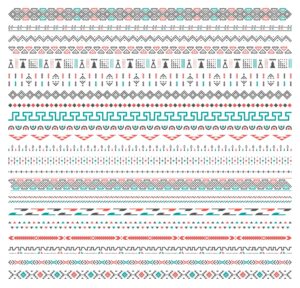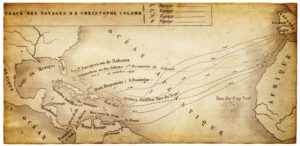Today is Indigenous Peoples’ Day, embraced by a growing list of cities, states and universities in the United States, as an alternative to Columbus Day, and meant to recognize the Native Americans who first inhabited the Americas.

In the more than 500 years after Columbus’ journey to the New World, millions of indigenous Americans died of exposure to Old Word diseases at the hands of European colonizers. While whole tribes and their culture were wiped out, the genetic legacies of some of these early Americans remain — particularly in Central and South America. Extensive mixing of historical populations – called “admixture” – resulted in new (admixed) genetic and cultural identities that define the people of the Americas today.
The First People of the Americas
The first people to populate the Americas, migrated across the land bridge that once connected Siberia to Alaska when the ice sheets receded some 15,000 years ago. Those people descended from populations that lived in northern and central Asia almost 30,000 years ago. Once they crossed into North America, they very quickly migrated south to populate all the Americas. Most Native Americans come from those early groups, although there is evidence of at least two later migrations — one group that contributed to the gene pool of Athabaskans found across western North America; and the other migration contributing to Eskimo-Aleuts.
Most indigenous American ancestry comes from these first Americans, but there is evidence for at least two later migrations; one contributing to the gene pool of the Athabaskans found across western North America and another contributing in large part to the Eskimo-Aleuts who live along the arctic and sub-arctic shores of Canada, Alaska, and Greenland. Their genes tell a story of migration, adaptation and diversity that is still being written today.
After Columbus

The genetic landscape of the Americas was irrevocably altered after 1492. Millions of indigenous Americans perished as a result of exposure to Old World diseases and genocide at the hands of European colonizers. Fewer than a half or one third of the more than 2,000 languages that were once spoken in the Americas remain, and lost with them were the rich diversity of cultures, but some of those people’s genetic legacies remain.
Indigenous People Today
Indigenous people are remain integral to the Americas today.
Some indigenous languages and language families still have over 1 million native speakers, including Mayan and Nahuatl (Aztec) in Central America, as well as Guarani, Aymara, and Quechua in South America.
While there are fewer native speakers of indigenous languages in North America than in Central or South America, several languages still have many native speakers: Navajo is spoken by nearly 200,000 people, while Cree and Ojibwe are each spoken by around 90,000 people. Other tribes have reinvigorated efforts to save and preserve their language and culture.
While 23andMe can reveal genetic evidence of Native American ancestry, it cannot identify specific tribal affiliations. Testing also shouldn’t be considered as a confirmatory test or proof of Native ancestry in a legal context. Beyond that testing may not be able to detect distant Native American ancestry in a customer’s family tree.




